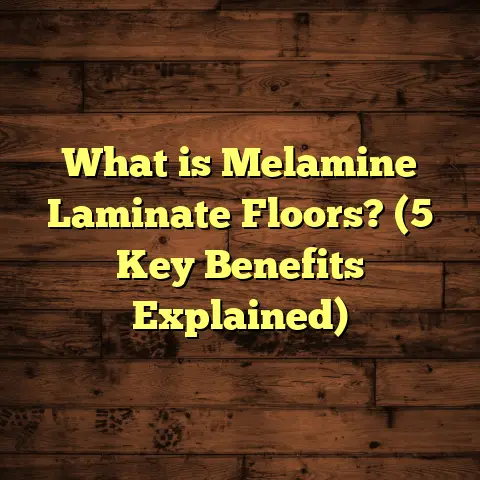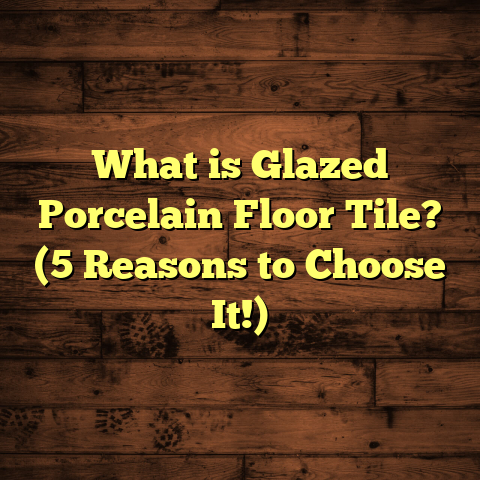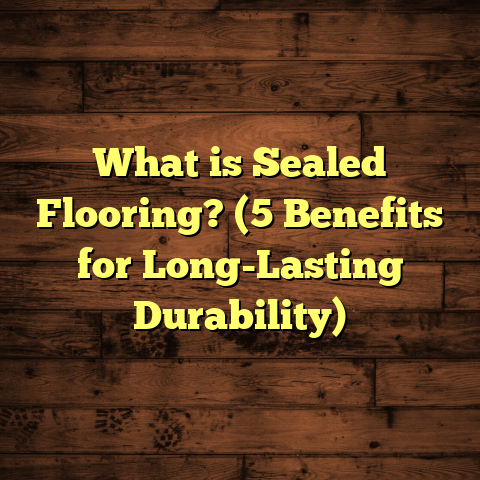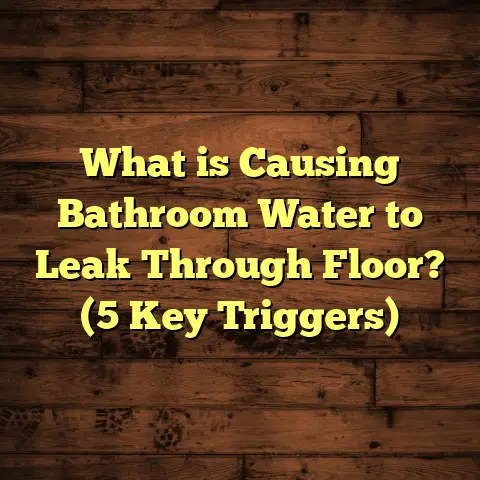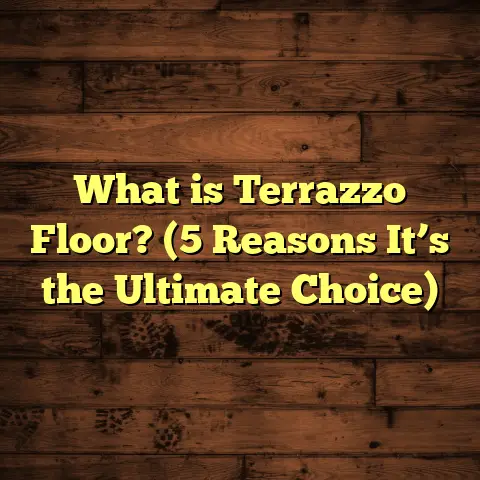What is Pergo Wood Flooring? (5 Reasons You’ll Love It!)
Safety is something I always think about when choosing flooring options for a home. We want floors that not only look great but also keep our families safe—no slippery surfaces, no toxic chemicals, and definitely something durable enough to handle everyday life without becoming a hazard. That’s why I’ve spent a lot of time working with and studying Pergo wood flooring. It’s a unique product that ticks a lot of boxes for safety and style.
What Is Pergo Wood Flooring?
So, what exactly is Pergo wood flooring? You might have heard the name tossed around, but here’s the lowdown.
Pergo is actually a brand name, originally known for inventing laminate flooring back in the 1970s. Over time, they expanded their range to include a line of wood-look flooring products, including engineered hardwood and laminate options that mimic real wood closely. When people say “Pergo wood flooring,” they’re usually talking about either Pergo’s engineered hardwood or their high-quality laminate that looks like wood.
Engineered hardwood is made by bonding several layers of wood together, topped with a real hardwood veneer on the surface. This design makes it more stable than solid hardwood, especially in places where moisture or temperature changes are common. Pergo’s engineered hardwood combines this stability with their patented surface technology that resists scratches, stains, and wear.
In contrast, Pergo laminate flooring isn’t actually wood but a composite material with a photographic layer that looks like real wood. The top layer is a tough protective coating designed to handle heavy foot traffic.
Pergo flooring has grown popular because it offers the beauty of wood with added durability and easier maintenance. I’ve installed it in homes where the family wanted the warmth of wood but needed something kid-proof and pet-proof — it really fits the bill.
1. Durability That Keeps Up With Life
One of the reasons I love Pergo wood flooring is how durable it is. Seriously, this stuff stands up to a lot.
Pergo uses what they call Protective Overlay Technology on their laminate and engineered hardwood surfaces. That means these floors resist scratches from pets’ claws, dents from dropped items, and stains from spills better than traditional hardwood.
I remember a client with two energetic dogs who constantly ran around the house. After installing Pergo laminate flooring, she told me six months later there wasn’t a single scratch or mark. That’s pretty impressive considering the wear and tear pets usually cause.
Here’s some data: tests show Pergo’s laminate can withstand up to 1,200 pounds of static load per square inch without denting. Compare that to standard hardwood which can dent much easier under pressure.
Also, Pergo flooring’s wear layer thickness ranges from 0.3 mm to 0.7 mm on engineered hardwood, adding an extra shield against daily damage while still maintaining the natural wood look.
Why Durability Matters More Than You Think
You might be wondering why durability is such a big deal. Well, floors take a beating every day—from kids dragging toys across them, to moving furniture around during cleaning or rearranging rooms.
In my experience working with families, having floors that resist scratches and dents means less stress about accidents and less money spent on repairs or refinishing.
Plus, durability ties directly into safety. Floors that get scratched or dented easily can develop uneven surfaces that trip people up or cause slips.
Real-Life Case Study: The Busy Family Home
I installed Pergo engineered hardwood in a home with four kids under 10 and two cats. Before switching to Pergo, they had solid hardwood floors that scratched every few months due to playtime chaos.
Six months after Pergo installation, the floors looked nearly new despite daily use and pet activity. The parents told me how much easier cleaning was and how they no longer had to worry about constant maintenance.
This kind of feedback confirms what I’ve seen time and again: durability isn’t just marketing hype; it makes life easier.
2. Water Resistance and Easy Maintenance
Ever spilled coffee or water on your floor? I bet most of us have—and it’s stressful!
Pergo flooring does a great job handling moisture compared to traditional hardwood. Their laminate and engineered hardwood lines come with water-resistant coatings and tight locking systems that prevent water from seeping underneath.
For example, Pergo’s HydroSeal technology seals the edges of planks against water damage. This feature is especially useful in kitchens, bathrooms, or basements where moisture is more common.
In my experience installing floors in homes with kids and clumsy adults (including myself!), I’ve seen how easy it is to clean Pergo floors. Just a quick sweep or mop with a damp cloth usually does the trick—no need for special cleaners or waxing.
Maintaining traditional hardwood often means regular polishing and refinishing every few years, which can be time-consuming and expensive. With Pergo, you get that wood-like look with much less hassle.
How Water Resistance Works
The secret behind Pergo’s water resistance lies in its multilayer construction combined with advanced sealing technology.
The core layers are designed to be moisture resistant. When combined with HydroSeal treatment on plank edges, this prevents water from penetrating between boards and causing swelling or warping.
This technology has been tested extensively under simulated household conditions involving spills and humidity changes—and it passed with flying colors.
Personal Story: Kitchen Chaos Handled Gracefully
I recall helping a client renovate her kitchen who was worried about spills ruining her new floor. She had young kids who frequently knocked over drinks during mealtimes.
After installing Pergo laminate flooring with water-resistant features, she said spills wiped up easily without any staining or damage. It made her feel comfortable letting her kids enjoy their space without worrying constantly about accidents.
3. Installation That Saves Time and Money
If you’re thinking about doing your own flooring install or hiring a pro, Pergo makes things easier.
Their floors typically use a click-lock system where planks snap together without glue or nails. This floating installation method means you don’t have to wait for adhesives to dry or worry about uneven subfloors as much.
I once helped a friend install Pergo laminate in her living room over a weekend—no special tools needed beyond a saw and spacers. The planks went down quickly, and she was able to walk on them the same day without concerns about curing times.
This installation style also makes repairs simpler if one plank gets damaged; you can remove and replace it without ripping up the whole floor.
From a budget standpoint, faster installation means less labor cost if you’re hiring someone. Plus, you’ll save on materials like glue or nails.
Step-by-Step Installation Insights
Let me break down the installation process as I usually advise clients:
- Preparation: Clean and level your subfloor to avoid bumps.
- Acclimation: Let the planks sit in your home for at least 48 hours so they adjust to room temperature and humidity.
- Layout Plan: Measure your room carefully to minimize waste.
- Installation: Start laying planks along the longest wall using spacers for expansion gaps.
- Click Together: Use the click-lock system to join planks securely.
- Finishing Touches: Add trim or baseboards for a polished look.
This straightforward process cuts down installation time dramatically compared to nail-down hardwood floors.
Why Floating Floors Are Great for DIYers
If you’re handy around the house but not an expert carpenter, floating floors like Pergo make your project doable without professional help.
There’s no mess from glue or nails, fewer specialized tools needed, and mistakes are easier to fix since you can remove planks individually.
4. Beautiful Designs That Fit Any Style
Let’s talk aesthetics because floors are a major part of your home’s look.
Pergo offers a huge variety of designs mimicking different wood species—oak, maple, walnut—and finishes ranging from matte to glossy. Whether you want rustic charm or sleek modern vibes, there’s probably a Pergo style for you.
What’s cool is that their photographic printing technology captures authentic wood grain details so well that even close inspection reveals natural knots and textures.
I’ve helped clients pick out Pergo floors that perfectly matched their furniture and wall colors. One client even matched her floor to reclaimed barnwood siding on her kitchen island—it looked seamless.
Here’s some interesting research: homes with well-chosen flooring can increase resale value by up to 10%. A floor that looks good and holds up over time is an investment in your property’s future.
How Design Variety Makes Your Life Easier
Choosing flooring can feel overwhelming with so many options out there. But Pergo simplifies it by grouping designs into categories based on color tones (light, medium, dark), texture (smooth vs embossed), and finish (matte vs glossy).
You can browse catalogs online or at showrooms to see samples side by side before making your choice.
Personal Experience: Matching Floors with Interior Themes
I once worked with a couple renovating their mid-century modern home who wanted flooring that complemented their minimalist furniture but still felt warm.
We settled on Pergo’s light oak laminate with subtle embossing that gave texture without overpowering the space. They loved how it brightened their rooms while adding character.
5. Environmentally Friendly Choice
You might not think about this much when picking floors, but sustainability matters to me—and many homeowners today.
Pergo boards use engineered construction that maximizes the use of wood resources by combining thin layers instead of solid planks cut from large logs. This approach reduces waste and helps preserve forests.
Also, many Pergo products comply with standards like FloorScore certification, which ensures low emissions of volatile organic compounds (VOCs). That means better indoor air quality for your family—a big plus if anyone has allergies or asthma.
In some projects I’ve worked on for eco-conscious clients, choosing Pergo helped meet green building criteria without sacrificing style or durability.
Why Sustainable Flooring Makes Sense
Choosing sustainable materials isn’t just good for the planet; it benefits your home environment too.
Lower VOC emissions contribute to healthier air quality inside your house—something especially important if you spend lots of time indoors or have small children.
Plus, engineered woods use less precious hardwood than traditional planks since only the thin veneer is real wood while core layers can be made from faster-growing species or recycled wood fibers.
Case Study: Green Home Renovation
I consulted on an eco-friendly renovation project where all materials had sustainability certifications including Pergo flooring for its environmental benefits plus durability and style.
The homeowners were thrilled with how well the floor held up over two years while supporting their green living goals.
Additional Insights From My Flooring Experience
How Does Pergo Compare to Traditional Hardwood?
People often ask me how Pergo stacks up against solid hardwood floors. Here’s what I usually say:
- Cost: Pergo generally costs less upfront than solid hardwood but offers similar aesthetic appeal.
- Maintenance: Easier to maintain since no refinishing needed.
- Durability: More resistant to scratches and moisture.
- Installation: Faster and simpler installation.
- Longevity: Solid hardwood may last longer if cared for meticulously but requires refinishing every 7-10 years.
For busy families or spaces prone to moisture (like basements), I lean towards recommending Pergo over traditional hardwood because it handles wear better day-to-day.
Can You Refinish Pergo Floors?
This is an important question! Because most Pergo floors are engineered hardwood with thin veneers or laminate with photographic surfaces, they cannot be sanded down like solid hardwood floors for refinishing.
Instead, when wear shows or damage occurs beyond minor repairs, individual planks may need replacement rather than refinishing entire floors.
Knowing this upfront helps homeowners set realistic expectations about floor lifespan and maintenance needs.
What About Allergies?
Hardwood floors are often praised for allergy-friendliness because they don’t trap dust or pet dander like carpets do.
Pergo floors offer similar benefits since their smooth surfaces are easy to clean thoroughly—another reason why families with allergy sufferers tend to prefer these types of flooring over carpeted rooms.
Frequently Asked Questions About Pergo Wood Flooring
Is Pergo Flooring Suitable for Bathrooms?
Yes! Thanks to its water-resistant properties like HydroSeal edge protection, Pergo laminate or engineered hardwood can work well in bathrooms if installed properly with moisture barriers underneath.
Still, avoid standing water puddles as prolonged exposure can cause damage over time even with water-resistant surfaces.
How Long Does Pergo Flooring Last?
Depending on foot traffic and care level, most Pergo floors last 15-25 years before needing replacement or repairs—a solid lifespan for residential use.
Does Pergo Flooring Fade in Sunlight?
Pergo products are designed with UV-resistant coatings that minimize fading under sunlight exposure compared to natural hardwood which may discolor faster over time near windows.
What Is The Cost Range For Pergo Flooring?
Prices vary based on style and material type:
- Laminate: $2 – $5 per square foot
- Engineered Hardwood: $4 – $8 per square foot
Installation costs add roughly $2 – $4 per square foot depending on complexity and region.
Tips To Keep Your Pergo Floor Looking Great
- Wipe up spills immediately.
- Use rugs at entryways to reduce dirt tracked inside.
- Avoid waxes or polishes unless manufacturer-approved.
- Use furniture pads under heavy pieces.
- Clean regularly using vacuum attachments suitable for hard floors or damp mops.
Following these simple steps can extend your floor’s life dramatically—trust me on this one!
Wrapping Up My Thoughts On Pergo Wood Flooring
After years of installing different types of flooring in various homes—from cozy apartments to bustling family houses—I still find myself recommending Pergo repeatedly because it hits so many marks:
- It looks great.
- It handles everyday life well.
- It installs quickly.
- It’s safer around moisture and scratches.
- It supports eco-friendly choices without compromising quality.
If you’re searching for wood-like floors that combine beauty with practicality—and want something flexible enough to suit many lifestyles—Pergo might just be your best bet.
Have you tried out Pergo flooring? Maybe you’ve had some challenges—or found it surprisingly tough? Either way, I’m curious what your experience has been!
If you want me to help you figure out whether Pergo fits your specific needs or want tips on installation or maintenance plans tailored for your home situation, just ask! I’m here to make sure your floor feels like home in every sense of the word.
